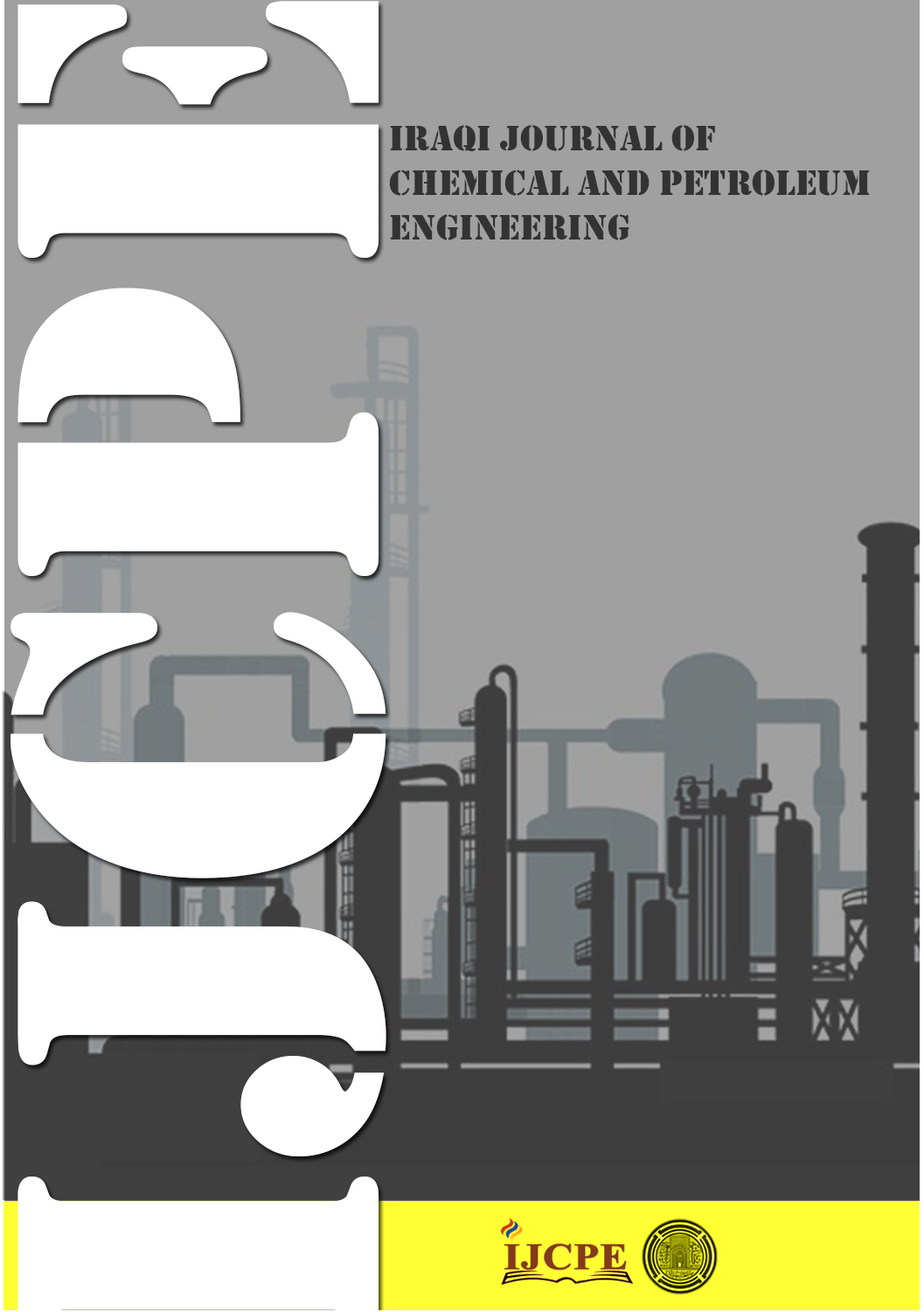Tetracycline removal from aqueous solution through photo-anodic oxidation process using rotating graphite cylinder anode
DOI:
https://doi.org/10.31699/IJCPE.2025.3.14Keywords:
Tetracycline; anodic oxidation; photo-oxidation; rotating anode; graphite; wastewatersAbstract
In the present work, tetracycline (TC) was removed from a simulated wastewater through a new photo-anodic oxidation process with a rotating graphite cylinder anode. The effects of current density, pH, rotation speed, and NaCl addition were evaluated. The results confirmed that increasing the current density results in improving the removal of TC. However, increasing the current density beyond 5 mA/cm2 had little effect on TC removal. Results revealed that TC removal using photoanodic oxidation can be achieved at high performance with an initial pH of 5. Increasing or decreasing pH beyond this value has a negative effect on TC removal. Increasing rotation speed gave better performance for TC removal due to the increase in mass transfer. The addition of NaCl improved the removal efficiency of TC due to the participation of indirect anodic oxidation within the oxidation process. The best conditions were: current density of 5mA/cm2, pH=5, 250 rpm, and the addition of 1 g/L NaCl, in which TC removal of 84% was achieved that claims (103 kWh/m3) as a total electrical energy consumption. In comparison with the anodic oxidation process alone, photo-anodic improved TC removal by an increment of (13.73%), confirming the photo-anodic process can be adopted successfully for treating wastewaters.
Received on 01/06/2025
Received in Revised Form on 09/08/2025
Accepted on 10/08/2025
Published on 30/09/2025
References
[1] X. Liu et al., “Photoelectrocatalytic degradation of tetracycline through C3N5/TiO2 nanotube arrays photoanode under visible light: Performance, DFT calculation and mechanism,” Journal of Environmental Chemical Engineering., vol. 11, no. 5, p. 110576, 2023, https://doi.org/10.1016/j.jece.2023.110576
[2] S. Wu and Y. H. Hu, “A comprehensive review on catalysts for electrocatalytic and photoelectrocatalytic degradation of antibiotics,” Chemical Engineering Journal., vol. 409, p. 127739, 2021, https://doi.org/10.1016/j.cej.2020.127739
[3] X. Chen, Y. Yang, Y. Ke, C. Chen, and S. Xie, “A comprehensive review on biodegradation of tetracyclines: Current research progress and prospect,” Science of The Total Environment., vol. 814, p. 152852, 2022, https://doi.org/10.1016/j.scitotenv.2021.152852
[4] B. K. Biswal and R. Balasubramanian, “Adsorptive removal of sulfonamides, tetracyclines and quinolones from wastewater and water using carbon-based materials: Recent developments and future directions,” Journal of Cleaner Production., vol. 349, p. 131421, 2022, https://doi.org/10.1016/j.jclepro.2022.131421
[5] Z. Yin, Y. Liu, S. Zhou, Z. Yang, and W. Yang, “Constructing zirconium based metal–organic frameworks based electrically-driven self-cleaning membrane for removal of tetracycline: Effect of ligand substitution,” Chemical Engineering Journal, vol. 450, p. 138100, 2022, https://doi.org/10.1016/j.cej.2022.138100
[6] L. Zhao, Y.-G. Zhao, C. Jin, D. Yang, Y. Zhang, and M. Progress, “Removal of tetracycline by ultraviolet/sodium percarbonate (UV/SPC) advanced oxidation process in water,” Environmental Research., vol. 247, p. 118260, 2024, https://doi.org/10.1016/j.envres.2024.118260
[7] S. Xin et al., “Heterogeneous photo-electro-Fenton degradation of tetracycline through nitrogen/oxygen self-doped porous biochar supported CuFeO2 multifunctional cathode catalyst under visible light,” Applied Catalysis B: Environmental., vol. 312, p. 121442, 2022, https://doi.org/10.1016/j.apcatb.2022.121442
[8] L. Jia et al., “Preparation of XCu@ TiO2 adsorbent for high-efficient PH3 removal in anaerobic environment and evaluation of desulfurization activity of deactivated adsorbent,” Chemical Engineering Journal., vol. 457, p. 141277, 2023 https://doi.org/10.1016/j.cej.2023.141277
[9] E. Brillas and S. Garcia-Segura, “Recent progress of applied TiO2 photoelectrocatalysis for the degradation of organic pollutants in wastewaters,” Journal of Environmental Chemical Engineering., vol. 11, no. 3, p. 109635, 2023, https://doi.org/10.1016/j.jece.2023.109635
[10] N. Entezami, M. Farhadian, A. R. S. Nazar, and S. Tangestaninejad, “Tetracycline removal from aqueous solution through photoelectrochemical oxidation process using Bi2O3/ZIF-67@ GP under visible light irradiation: effects of operational parameters, water matrix,” Chemical Engineering and Processing - Process Intensification., vol. 188, p. 109370, 2023, https://doi.org/10.1016/j.cep.2023.109370
[11] Y. Wang et al., “Degradation of tetracycline in aqueous media by ozonation in an internal loop-lift reactor,” Journal of Hazardous Materials., vol. 192, no. 1, pp. 35–43, 2011, https://doi.org/10.1016/j.jhazmat.2011.04.086
[12] Y. Zhuang et al., “Enhanced antibiotic removal through a dual-reaction-center Fenton-like process in 3D graphene based hydrogels,” Environmental Science: Nano, vol. 6, no. 2, pp. 388–398, 2019 https://doi.org/10.1039/C8EN01339J
[13] Y. Chen, R. Zou, and Q. Wu, “Facile synthesis of hollow ZnO/HAp microsphere photocatalysts for efficient removal of tetracycline under full light irradiation,” Inorganic Chemistry Communications., p. 114084, 2025, https://doi.org/10.1016/j.inoche.2025.114084
[14] R. Yang et al., “One-step preparation (3D/2D/2D) BiVO4/FeVO4@ rGO heterojunction composite photocatalyst for the removal of tetracycline and hexavalent chromium ions in water,” Chemical Engineering Journal., vol. 390, p. 124522, 2020, https://doi.org/10.1016/j.cej.2020.124522
[15] J. Lyu, Z. Hu, Z. Li, and M. Ge, “Removal of tetracycline by BiOBr microspheres with oxygen vacancies: Combination of adsorption and photocatalysis,” Journal of Physics and Chemistry of Solids, vol. 129, pp. 61–70, 2019, https://doi.org/10.1016/j.jpcs.2018.12.041
[16] G. H. Safari, M. Hoseini, M. Seyedsalehi, H. Kamani, J. Jaafari, and A. H. Mahvi, “Photocatalytic degradation of tetracycline using nanosized titanium dioxide in aqueous solution,” International Journal of Environmental Science and Technology., vol. 12, pp. 603–616, 2015, https://doi.org/10.1007/s13762-014-0706-9
[17] X. Zhang, H. Deng, G. Zhang, F. Yang, and G.-E. Yuan, “Natural bornite as an efficient and cost-effective persulfate activator for degradation of tetracycline: performance and mechanism,” Chemical Engineering Journal., vol. 381, p. 122717, 2020, https://doi.org/10.1016/j.cej.2019.122717
[18] R. Guan et al., “Accelerated tetracycline degradation by persulfate activated with heterogeneous magnetic NixFe3− xO4 catalysts,” Chemical Engineering Journal vol. 350, pp. 573–584, 2018, https://doi.org/10.1016/j.cej.2018.05.195
[19] J. Li et al., “Electrochemical Oxidation Mechanism of Tetracycline in Various Supporting Electrolytes Based on a Boron‐Doped Diamond Anode,” physica status solidi (a)vol. 222, no. 5, p. 2400786, 2025, https://doi.org/10.1002/pssa.202400786
[20] Y. Chen et al., “Electrochemical oxidation of low concentrated tetracycline (TC) in aqueous solution: Operation optimization, degradation mechanisms, and detoxification efficiency,” Journal of Environmental Chemical Engineering., vol. 12, no. 3, p. 112604, 2024, https://doi.org/10.1016/j.jece.2024.112604
[21] M. Rodríguez-Peña, R. Natividad, C. E. Barrera-Díaz, P. B. Hernández, C. I. A. Ramírez, and G. Roa-Morales, “Current perspective of advanced electrochemical oxidation processes in wastewater treatment and life cycle analysis,” International Journal of Electrochemical Science., vol. 19, no. 7, p. 100589, 2024, https://doi.org/10.1016/j.ijoes.2024.100589
[22] V. Muthukumar and H. Manoharan, “Introduction to Wastewater Treatment Using Various Electrochemical Methods,” in Electrochemical Perspective Towards Wastewater Treatment, Springer, 2025, pp. 1–26. https://doi.org/10.1007/978-981-96-0652-8_1
[23] F. C. Moreira, R. A. R. Boaventura, E. Brillas, and V. J. P. Vilar, “Electrochemical advanced oxidation processes: a review on their application to synthetic and real wastewaters,” Applied Catalysis B: Environmental., vol. 202, pp. 217–261, 2017, https://doi.org/10.1016/j.apcatb.2016.08.037
[24] J. P. T. da S. Santos, J. Tonholo, A. R. de Andrade, V. Del Colle, and C. L. de P. e S. Zanta, “The electro-oxidation of tetracycline hydrochloride in commercial DSA® modified by electrodeposited platinum,” Environmental Science and Pollution Research, vol. 28, pp. 23595–23609, 2021, https://doi.org/10.1007/s11356-020-09919-2
[25] C. C. Jara, D. Fino, V. Specchia, G. Saracco, and P. Spinelli, “Electrochemical removal of antibiotics from wastewaters,” Applied Catalysis B: Environmental vol. 70, no. 1–4, pp. 479–487, 2007, https://doi.org/10.1016/j.apcatb.2005.11.035
[26] M. D. Vedenyapina, Y. N. Eremicheva, V. A. Pavlov, and A. A. Vedenyapin, “Electrochemical degradation of tetracycline,” Russian Journal of Applied Chemistry., vol. 81, pp. 800–802, 2008, https://doi.org/10.1134/S1070427208050145
[27] X. Li et al., “Electrochemical degradation of tetracycline hydrochloride in sulfate solutions on boron-doped diamond electrode: The accumulation and transformation of persulfate,” Chemosphere, vol. 305, p. 135448, 2022, https://doi.org/10.1016/j.chemosphere.2022.135448
[28] B. K. Körbahti and S. Alaca, “Electrochemical degradation of tetracycline antibiotic with boron-doped diamond electrodes and effect of parameters on removal of reaction intermediates,” Desalination and Water Treatment., vol. 236, pp. 285–299, 2021, https://doi.org/10.5004/dwt.2021.27716
[29] C. I. Brinzila, N. Monteiro, M. J. Pacheco, L. Ciríaco, I. Siminiceanu, and A. Lopes, “Degradation of tetracycline at a boron-doped diamond anode: influence of initial pH, applied current intensity and electrolyte,” Environmental Science and Pollution Research, vol. 21, pp. 8457–8465, 2014, https://doi.org/10.1007/s11356-014-2778-y
[30] C. I. Brinzila, M. J. Pacheco, L. Ciríaco, R. C. Ciobanu, and A. Lopes, “Electrodegradation of tetracycline on BDD anode,” Chemical Engineering Journal vol. 209, pp. 54–61, 2012, https://doi.org/10.1016/j.cej.2012.07.112
[31] M. Shi, H. Wang, P. Yuan, X. Xu, and J. Yang, “Degradation of tetracycline hydrochloride by electrocatalytic oxidation using NiO@ Co3O4/Ti electrode,” Journal of Water Process Engineering, vol. 61, p. 105242, 2024, https://doi.org/10.1016/j.jwpe.2024.105242
[32] H. Dong, W. Chi, A. Gao, T. Xie, and B. Gao, “Electrochemical degradation of tetracycline using a Ti/Ta2O5-IrO2 anode: performance, kinetics, and degradation mechanism,” Materials (Basel)., vol. 14, no. 15, p. 4325, 2021, https://doi.org/10.3390/ma14154325
[33] J. Wang, D. Zhi, H. Zhou, X. He, and D. Zhang, “Evaluating tetracycline degradation pathway and intermediate toxicity during the electrochemical oxidation over a Ti/Ti4O7 anode,” Water Research, vol. 137, pp. 324–334, 2018, https://doi.org/10.1016/j.watres.2018.03.030
[34] S. Liang, H. Lin, X. Yan, and Q. Huang, “Electro-oxidation of tetracycline by a Magnéli phase Ti4O7 porous anode: Kinetics, products, and toxicity,” Chemical Engineering Journal vol. 332, pp. 628–636, 2018, https://doi.org/10.1016/j.cej.2017.09.109
[35] K. Xia et al., “Efficient electrocatalytic oxidation of tetracycline in water using a SnO2-Sb/FTO electrode,” Journal of Water Process Engineering vol. 70, p. 107090, 2025, https://doi.org/10.1016/j.jwpe.2025.107090
[36] K. Yang, Y. Liu, J. Liu, and J. Qiao, “Preparation optimization of multilayer-structured SnO2–Sb–Ce/Ti electrode for efficient electrocatalytic oxidation of tetracycline in water,” Chinese Journal of Chemical Engineering., vol. 26, no. 12, pp. 2622–2627, 2018, https://doi.org/10.1016/j.cjche.2018.08.010
[37] D. Zhi, J. Qin, H. Zhou, J. Wang, and S. Yang, “Removal of tetracycline by electrochemical oxidation using a Ti/SnO 2–Sb anode: Characterization, kinetics, and degradation pathway,” Journal of Applied Electrochemistry., vol. 47, pp. 1313–1322, 2017, https://doi.org/10.1007/s10800-017-1125-7
[38] T. Xie, H. Hu, D. Chen, and P. Sun, “Electrochemical Degradation of Tetracycline Hydrochloride in Aqueous Medium by (B4C/C)‐β‐PbO2 Electrode,” Bulletin of the Korean Chemical Society, vol. 38, no. 7, pp. 756–762, 2017, https://doi.org/10.1002/bkcs.11166
[39] I. Yahiaoui, F. Aissani-Benissad, F. Fourcade, and A. Amrane, “Removal of tetracycline hydrochloride from water based on direct anodic oxidation (Pb/PbO2 electrode) coupled to activated sludge culture,” Chemical Engineering Journal, vol. 221, pp. 418–425, 2013, https://doi.org/10.1016/j.cej.2013.01.091
[40] W. Wu, Z.-H. Huang, and T.-T. Lim, “A comparative study on electrochemical oxidation of bisphenol A by boron-doped diamond anode and modified SnO2-Sb anodes: influencing parameters and reaction pathways,” Journal of Environmental Chemical Engineering vol. 4, no. 3, pp. 2807–2815, 2016, https://doi.org/10.1016/j.jece.2016.05.034
[41] H. Lin et al., “Highly efficient and mild electrochemical mineralization of long-chain perfluorocarboxylic acids (C9–C10) by Ti/SnO2–Sb–Ce, Ti/SnO2–Sb/Ce–PbO2, and Ti/BDD electrodes,” Environmental Science & Technology, vol. 47, no. 22, pp. 13039–13046, 2013, https://doi.org/10.1021/es4034414
[42] İ. Y. Köktaş, Ö. Gökkuş, İ. A. Kariper, and A. Othmani, “Tetracycline removal from aqueous solution by electrooxidation using ruthenium-coated graphite anode,” Chemosphere, vol. 315, p. 137758, 2023, https://doi.org/10.1016/j.chemosphere.2023.137758
[43] A. S. Abdalrhman, Y. Zhang, and M. G. El-Din, “Electro-oxidation by graphite anode for naphthenic acids degradation, biodegradability enhancement and toxicity reduction,” Science of The Total Environment., vol. 671, pp. 270–279, 2019, https://doi.org/10.1016/j.scitotenv.2019.03.262
[44] C. Xu, S. Zhao, S.-G. Wang, and C. Song, “Enhanced photolysis of tetracycline by Zn (II): Role of complexation,” Science of The Total Environment vol. 909, p. 168484, 2024, https://doi.org/10.1016/j.scitotenv.2023.168484
[45] C. Xu, Y. Feng, X.-X. Zhao, S. Zhao, S.-G. Wang, and C. Song, “Mechanisms of Cu(II)enhancing photolysis of tetracycline under UV irradiation,” Chemical Engineering Journal., vol. 474, p. 145510, 2023, https://doi.org/10.1016/j.cej.2023.145510
[46] S. Li, Y. He, F. Kong, W. Sun, and J. Hu, “Photolytic degradation of tetracycline in the presence of Ca (II) and/or humic acid,” Water, vol. 12, no. 8, p. 2078, 2020, https://doi.org/10.3390/w12082078
[47] J. J. López-Peñalver, M. Sánchez-Polo, C. V Gómez-Pacheco, and J. Rivera-Utrilla, “Photodegradation of tetracyclines in aqueous solution by using UV and UV/H₂O₂ oxidation processes,” Journal of Chemical Technology & Biotechnology, 2010, https://doi.org/10.1002/jctb.2435
[48] M. Klavarioti, D. Mantzavinos, and D. Kassinos, “Removal of residual pharmaceuticals from aqueous systems by advanced oxidation processes,” Environment International vol. 35, no. 2, pp. 402–417, 2009 https://doi.org/10.1016/j.envint.2008.07.009
[49] F. H. Abd and A. H. Abbar, “Treatment of hospital wastewater by anodic oxidation using a new approach made by combining rotation with pulsed electric current on Cu-SnO2–Sb2O5 rotating cylinder anode,” Heliyon, 2025, https://doi.org/10.1016/j.heliyon.2025.e42069
[50] F. H. Abd and A. H. Abbar, “An innovative combination of anodic oxidation using Cu/SnO2–Sb2O5 rotating cylinder anode with TiO2 photocatalytic process for treating hospital wastewater,” Journal of Industrial and Engineering Chemistry., vol. 145, pp. 668–685, 2025, https://doi.org/10.1016/j.jiec.2024.10.064
[51] J. R. Bolton, K. G. Bircher, W. Tumas, and C. A. Tolman, “Figures-of-merit for the technical development and application of advanced oxidation technologies for both electric-and solar-driven systems (IUPAC Technical Report),” Pure and Applied Chemistry., vol. 73, no. 4, pp. 627–637, 2001, https://doi.org/10.1351/pac200173040627
[52] H. Lin, J. Niu, J. Xu, Y. Li, and Y. Pan, “Electrochemical mineralization of sulfamethoxazole by Ti/SnO2-Sb/Ce-PbO2 anode: kinetics, reaction pathways, and energy cost evolution,” Electrochim. Acta, vol. 97, pp. 167–174, 2013, https://doi.org/10.1016/j.electacta.2013.03.019
[53] B. Jiang, F. Liu, Y. Pan, Y. Tan, C. Shuang, and A. Li, “Preparation of Graphite-UiO-66 (Zr)/Ti electrode for efficient electrochemical oxidation of tetracycline in water,” PLoS One, vol. 17, no. 8, p. e0271075, 2022, https://doi.org/10.1371/journal.pone.0271075
[54] H. Yu et al., “Preparation of nickel and sodium dodecyl sulfate co-doped PbO2 electrode and its enhanced electrocatalytic oxidation of tetracycline,” Materials Science and Engineering: B vol. 298, p. 116890, 2023, https://doi.org/10.1016/j.mseb.2023.116890
[55] S. Yu, H. Zhang, Y. Zhou, and C. Li, “Enhanced electrocatalytic degradation of tetracycline by ZIF-67@ CNT coupled with a self-standing aligned carbon nanofiber anodic membrane,” Nanotechnology, vol. 35, no. 14, p. 145701, 2024, https://doi.org/10.1088/1361-6528/ad183c
[56] C. Wang, L. Chang, X. Zhang, H. Chai, and Y. Huang, “Promoting oxygen vacancies utility for tetracycline degradation via peroxymonosulfate activation by reduced Mg-doped Co3O4: Kinetics and key role of electron transfer pathway,” Environmental Research., vol. 252, p. 118892, 2024, https://doi.org/10.1016/j.envres.2024.118892
[57] X. Li, B. Yang, K. Xiao, H. Duan, J. Wan, and H. Zhao, “Targeted degradation of refractory organic compounds in wastewaters based on molecular imprinting catalysts,” Water Research., vol. 203, p. 117541, 2021, https://doi.org/10.1016/j.watres.2021.117541
[58] Y. Zhang et al., “Ti/PbO2-Sm2O3 composite based electrode for highly efficient electrocatalytic degradation of alizarin yellow R,” Journal of Colloid and Interface Science, vol. 533, pp. 750–761, 2019, https://doi.org/10.1016/j.jcis.2018.09.003
[59] A. B. Salman and S. N. Abdulqahar, “Electrochemical oxidation of methyl blue dye using stainless steel rotating cylinder anode,” Desalination and Water Treatment., vol. 300, pp. 158–166, 2023, https://doi.org/10.5004/dwt.2023.29713
[60] R. N. Abbas and A. S. Abbas, “Feasibility of using carbon fiber, graphite, and their modified versions by PbO2 as electrodes in electrochemical oxidation of phenolic wastewater,” in AIP Conference Proceedings, AIP Publishing, 2022, https://doi.org/10.1063/5.0107718
[61] Y. Zhang, M.-M. Gao, X.-H. Wang, S.-G. Wang, and R.-T. Liu, “Enhancement of oxygen diffusion process on a rotating disk electrode for the electro-Fenton degradation of tetracycline,” Electrochim. Acta, vol. 182, pp. 73–80, 2015 https:/doi.org/10.1016/j.electacta.2015.08.134
[62] O. M. Cornejo et al., “Recent advances in electrochemical flow reactors used in advanced oxidation processes: A critical review,” Chemical Engineering Journal., p. 153935, 2024, https://doi.org/10.1016/j.cej.2024.153935
[63] R. H. Salman, M. H. Hafiz, and A. S. Abbas, “The performance of MnO2/graphite electrode for TOC removal from wastewater by indirect electrochemical oxidation process,” in IOP Conference Series: Materials Science and Engineering, IOP Publishing, 2018, p. 12148, https://doi.org/10.1088/1757-899X/454/1/012148
[64] J. Wang, X. Chen, J. Yao, and G. Huang, “Decomplexation of electroplating wastewater in a higee electrochemical reactor with rotating mesh-disc electrodes,” International Journal of Electrochemical Science, vol. 10, no. 7, pp. 5726–5736, 2015, https://doi.org/10.1016/S1452-3981(23)17290-7
[65] C. M. Dominguez, N. Oturan, A. Romero, A. Santos, and M. A. Oturan, “Lindane degradation by electrooxidation process: effect of electrode materials on oxidation and mineralization kinetics,” Water Research., vol. 135, pp. 220–230, 2018, https://doi.org/10.1016/j.watres.2018.02.037
[66] Z. Frontistis and S. Meriç, “The role of operating parameters and irradiation on the electrochemical degradation of tetracycline on boron doped diamond anode in environmentally relevant matrices,” Journal of Chemical Technology & Biotechnology., vol. 93, no. 12, pp. 3648–3655, 2018, https://doi.org/10.1002/jctb.5750
[67] X. Lian, S. Ye, B. Liu, Y. Shu, Z. Ao, and H. Huang, “Key role of• O2− in promoting deep degradation of VOCs in VUV-based process,” Science of The Total Environment., vol. 883, p. 163806, 2023, https://doi.org/10.1016/j.scitotenv.2023.163806
[68] J. Wu, H. Zhang, N. Oturan, Y. Wang, L. Chen, and M. A. Oturan, “Application of response surface methodology to the removal of the antibiotic tetracycline by electrochemical process using carbon-felt cathode and DSA (Ti/RuO2–IrO2) anode,” Chemosphere, vol. 87, no. 6, pp. 614–620, 2012, https://doi.org/10.1016/j.chemosphere.2012.01.036
Downloads
Published
Issue
Section
License
Copyright (c) 2025 The Author(s). Published by College of Engineering, University of Baghdad.

This work is licensed under a Creative Commons Attribution 4.0 International License.













